
Drip Irrigation
Abstract
Despite the impressive gains in global food production over the past half century, an estimated one out of five in the developing world, are chronically hungry. Many of the chronically hungry are poor farm families, who have neither the means to produce the food they need nor sufficient income to purchase it. For them, access to irrigation water, or the means to use the water they have more productively, is a key to increasing their crop production, their incomes and their household food security. Ironically, a technology typically associated with wealthy farmers, drip irrigation, may hold the key to alleviating a significant share of rural hunger and poverty.
In semi-arid areas where water
is precious, large farmers use drip irrigation to minimize evaporation losses by
delivering water directly to the roots of plants.
At a cost of around $750 an acre for crops like vegetables, current drip
systems are not affordable for small farmers in
The following innovations may be
considered to make drip irrigation affordable to small farmers in

Fig. Schematic of a Bucket Kit
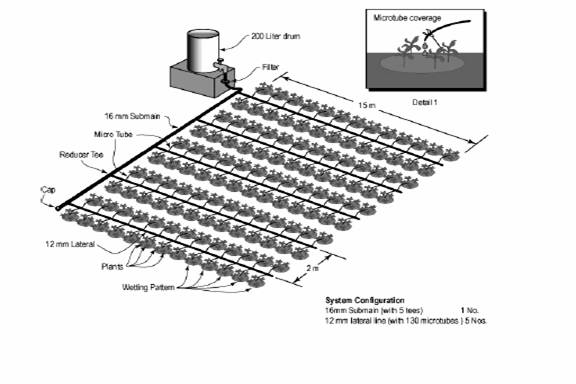
Fig. Schematic of a Drum Kit, Micro tube version
The treadle pump is a foot-operated device that uses a bamboo or PVC or a flexible pipe as suction/ tube-well to pump water from shallow aquifers or surface water bodies. It consists of a sheet metal or cast iron pump-head, a bamboo frame with two treadles and a bamboo or PVC strainer. The pump-head has two cylinders welded together with a single suction inlet at the bottom and two plungers with or without a rope and pulley. The cylinders are joined together at the base by a junction box, which connects through check valves to the suction pipe. As pedaling commences, water penetrates the filter and rises up through the suction pipe to the dynamic groundwater level. The action of the two cylinders provides a virtually continuous stream of water.
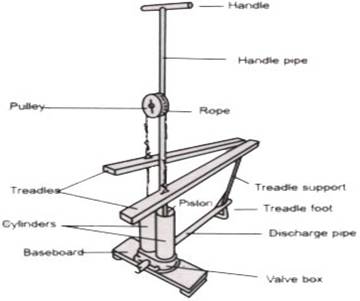
Fig. Schematic of a Treadle Pump
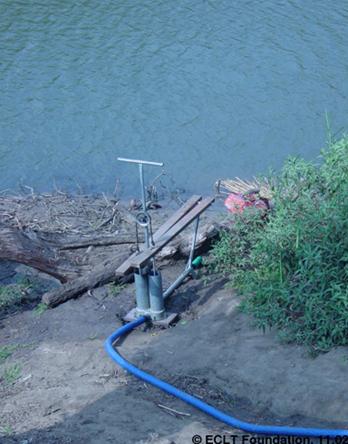
Fig. Photograph showing a Treadle Pump
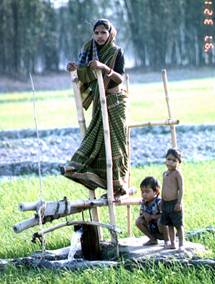
Fig. A woman operating a Treadle Pump in
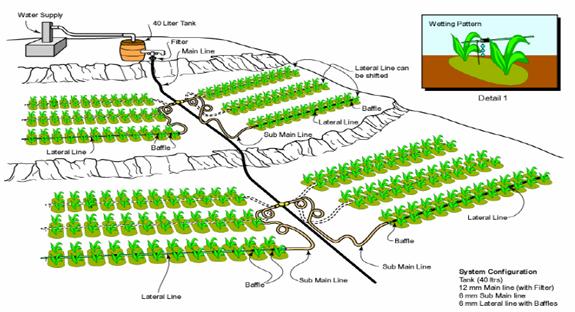
Fig. Schematic of a Drum Kit, Shiftable Hole and Baffle Version
1. Use of a Pitchfork: By using a pitchfork in a new and/or large bed with little or no existing crop, it is possible to get out most of the roots of long rooted weeds. To use a pitchfork for weed control, push it under a group of weeds and lift them. Shake the soil off the weeds and dispose of them in the compost pile.
2. Mulch: Mulch is any material placed over soil. It is designed to retain moisture, deter weeds and keep the soil from eroding. As long as mulch is applied thick enough to keep sunlight from reaching the soil, it will keep new weeds from sprouting. You can use shredded and chipped branches, weed free hay, leaves or compost for Mulch.
3. Weed Barrier Fabric: Weed barrier fabrics are woven polymer barriers that block light for to prevent weed growth yet allow water and air to pass through the barrier.
4. Mowing: Keeping weeds mowed regularly can be an effective method of reducing the vigor and prevent them from going to seed. Mowing must be frequent enough to prevent the weeds from storing enough energy between mowings . Frequent mowing during the growing season will "starve" weeds and eventually kill the roots, but only if the plant is not given enough time to recover stored energy between mowings. Mowing must be done at least once in 10 days.
5. Weed Burners: Use a weed burner to destroy surface roots and plant material. A bottled gas weed burner can be inexpensive and effective. The flame only has to be on the plant material briefly to rupture the plant cells and cause tissue death.
Despite all of drip irrigation's potential benefits, converting to drip irrigation can increase production costs, especially where an irrigation system already is in place. Making the system automated increases the investment costs and it is generally recommended for larger areas of land. Ultimately, there must be an economic advantage to drip irrigation to make it worthwhile.